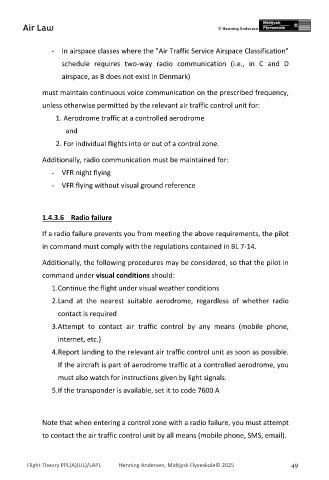Page 49 - PPL-engelsk 2025
P. 49
Air Law
- In airspace classes where the "Air Traffic Service Airspace Classification"
schedule requires two-way radio communication (i.e., in C and D
airspace, as B does not exist in Denmark)
must maintain continuous voice communication on the prescribed frequency,
unless otherwise permitted by the relevant air traffic control unit for:
1. Aerodrome traffic at a controlled aerodrome
and
2. For individual flights into or out of a control zone.
Additionally, radio communication must be maintained for:
- VFR night flying
- VFR flying without visual ground reference
1.4.3.6 Radio failure
If a radio failure prevents you from meeting the above requirements, the pilot
in command must comply with the regulations contained in BL 7-14.
Additionally, the following procedures may be considered, so that the pilot in
command under visual conditions should:
1. Continue the flight under visual weather conditions
2. Land at the nearest suitable aerodrome, regardless of whether radio
contact is required
3. Attempt to contact air traffic control by any means (mobile phone,
internet, etc.)
4. Report landing to the relevant air traffic control unit as soon as possible.
If the aircraft is part of aerodrome traffic at a controlled aerodrome, you
must also watch for instructions given by light signals.
I
5. f the transponder is available, set it to code 7600 A
Note that when entering a control zone with a radio failure, you must attempt
to contact the air traffic control unit by all means (mobile phone, SMS, email).
Flight Theory PPL(A)(UL)/LAPL Henning Andersen, Midtjysk Flyveskole© 2025 49

